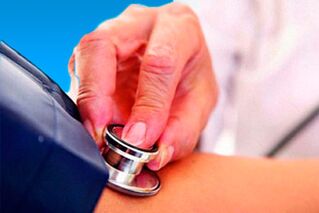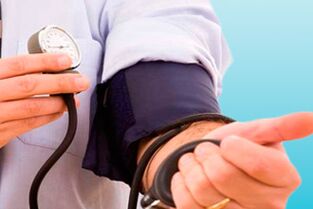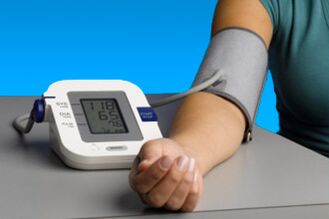
Breach of blood pressure causes failures of the entire organism. Despite the fact that this disease cannot be completely cured, the course of the disease can be made less noticeable and problematic for the patient.
Michen bodies
Arterial hypertension is a chronic disease that is associated with increased pressure within vascular walls. In this case, it is very important to distinguish rare situations when a person increase the pressure and the right manifestation of this disease. One-way to increase in various reasons may occur, and often do not repeat it soon. The cause may be the excitement of a person, hormonal failures or injuries.
Asking the question of what arterial hypertension, it is necessary to deal with the term "hypertension". This is a temporary increase in blood pressure over 140/90. But hypertension in medicine is called a condition in which a person has complex indicators. They rarely fall under these numbers alone.
The negative side of this disease is that it does not only suffer the cardiovascular system of chronic high pressure. There is such a thing as the target bodies in medicine. The essence of the problem is that constantly increased blood pressure negatively affects numerous organs - the heart, kidneys, brain and retina. The disease will negatively affect the whole body, but they suffer in the first place. Even the principle of classification of the disease depends on which body is on which the negative effect is done.
Stages of the disease
The disease has different forms that depend on which principle classifies. They may depend on the origin, on the exchange rate and at the level of blood pressure. The easiest form of arterial hypertension is the easiest, because patients can find out their pressure at home.
Like other diseases, the development of hypertension has several degrees that only worsens without the required treatment. There are norms that help determine the disease phase. You cannot extract conclusions after one or two measurements of the person's pressure, as this approach can give incorrect indicators. If a person is before she took certain drugs or there was an emotional increase, and more emotions were bad or well, indicators can change. It won't let you see the actual picture of the patient's health.
Do not confuse high pressure, which is within the normal range, which is a manifestation of arterial hypertension. Pressure 120/80 is considered normal for the human body, but the pressure can be classified as 129/84. The pressure is considered an increase to 139/89, but not classified as the degree of hypertension. Hypertension is considered a pressure that exceeds 140/90.
Table 1. Degree of hypertension and pressure level
| Degree of arterial hypertension | Indicators |
|---|---|
| Norm | From 120/80 to 139/89 |
| 1 degree of hypertension | From 140/90 to 159/99 |
| 2 degrees of hypertension | From 160/100 to 179/109 |
| 3 degrees of hypertension | From 180/110 and above |

In addition to the definition of "hypertension" and classification of disease according to the degree of development, there is also a primary and secondary hypertension unit. Primary develops as independent pathology, and often other problems in the human body were not found in this case. If we are talking about secondary hypertension, then it becomes the result of existing diseases in the human body.
First degree
It is considered a slight form of disease, blood pressure indicators do not exceed 160/100, and attacks, mostly without serious consequences. The arterial hypertension of the first degree is characterized by spasmodic disorders that occur in the work of the heart. Darious periods can hardly be called rare, but due to a small manifestation and chronic flow of illness, the patient is quite easy. Deterioration is exchanged with normal indicators, during this period, the patient does not feel the symptoms of the disease.
To adequately assess the situation, it is necessary to make pressure measurements using Tonometers several times a day. It is usually done three times a day in the absence of emotional bursts or other reasons that may affect a change in short terms in blood pressure.
Arterial hypertension 1. The degree has its symptoms, which patients often cannot take seriously. The disease can manifest a headache, fast beat or pain on the left side in the sternum. Often patients are confused by the fact that first-degree hypertension rarely characterize symptoms.
But even a slight degree of hypertension can have their own complications, which in the human body are full of serious disorders. This:
- Microinfarcts of the brain;
- Muscle Heart HeartRophy;
- Nephrosclerosis.
It is wrong to assume that arterial hypertency 1. Degrees can pass without a trace if healed with medications. It can be argued that the patient suffers from the first degree of hypertension, there is a risk of complications. Statistics show approximately 15% of such probability.
When the patient is diagnosed with the first-degree hypertension, the situation is as follows: High pressure can be started with narrowed vessels in a bowl, leading to insufficient body tissue nutrition. In the absence of a normal amount of nutrients and oxygen in cells, necrosis is developing. Initially, this process is not noticeable, but over time, some are bodies in the patient's body, not just certain cells, can occur over time. Lack of treatment causes the ischemic gait.
If the patient has high blood pressure, and even hypertension 1. Degree gives a very high risk of developing heart problems.
Change the indicator in the larger direction gives an additional heart load, which attempts to push the blood through the narrow vessels of the vessel, is flooded. Everyone knows that with additional load muscles are beginning to grow, it happens with heart tissues. It may seem that hypertension of the first degree of risk reduces the risk, because the heart can pump blood more efficiently, but that is not entirely true. Cardiomyopathy can squeeze vessels in the immediate vicinity, and even cause death.
Second degree

In the second degree of arterial hypertension, the patient will be at the level of up to 180/110 mm Hg. In this case, patients in patients are much higher than hypertension 1. degrees, the risk of complications on which occurs less often.
The second degree of hypertension is characterized by the fact that the pressure is extremely seldom rarely in normal, can be reduced and increased, but do not reach permissible borders. Typically, first-degree hypertension has the risk of moving to the same disease 2. degrees, then it is possible to determine the appearance of Benign or malignant arterial hypertension. To clarify such arterial hypertension, what is wearing, and which risks emerge helps the development of pathology.
In patients, vascular deficiency, head pulsation, hyperemia, visuality problems of visual and hypertensive crises are added to already known symptoms. The problem of the latter is that the pressure can be dramatically changed by 59 units, which negatively affects the patient's body. In the second degree of hypertension, complications are possible:
- brain thrombosis;
- Aorta aneurysism;
- atherosclerosis;
- angina pectoris;
- Encephalopathy.
The uniqueness of this degree of development of hypertension is to show the defeat of targeted organs. In patients with such a diagnosis, bleeds are possible in one of the bodies. This is due to the fact that, at a later degree of arterial hypertension, the blood vessels lose the former elasticity and can be much easier to collapse. There are also serious risks of forming blood clots on the walls of blood vessels, lumen in which it is already reduced.
Due to serious problems that can occur in the second degree of arterial hypertension, the patient can get disability. They most often give 3 groups. But that does not mean that it is enough for the patient to measure pressure several times and show that it exceeds the permission of the norm. The Commission takes into account the complications that appeared in the background of this disease, collects information on hypertension, as well as the patient's work conditions - only after that we can discuss receipt of cash benefits.
The Commission takes into account the complications that appeared in the background of this disease, collects information on hypertension, as well as the patient's work conditions - only after that we can discuss receipt of cash benefits.
The paradox of the situation is that some patients try to get this help in the first symptoms, while others, on the contrary, hide their disease. Most often, employees who can fire due to working conditions that will rely after that (more sick leave, increase the annual leave). But we must not forget that in the second degree of hypertension, additional load can have serious consequences that will quickly exacerbate the disease.
It is worth noting a special case that is possible in the second degree of arterial hypertension. When it comes to malignant pathology, the Commission may assign 2 groups for people with disabilities. Men older than 60 years old, older than 55 years, as well as patients who have irreversible shortcomings have found disability for a living. This means that there will be no need to transfer the Commission a year to confirm the status.
Third degree
Pressing a person can determine the degree of illness. When the indicators start reaching extremely high rates - from 180/110 mm HG, the patient is diagnosed with a third, difficult degree of hypertension. In this case, complications are very serious, most of them, with the untimely provision of medical care, can lead to death. It can be a stroke, heart asthma, myocardial infarction, kidney failure and other diseases.
Assessing the severity of this degree Patients are assigned 1 group of disability. Evaluation of the risk of disease development, the patient must take the rehabilitation without failure. There is no need to discuss the treatment of this degree, but this approach will help to avoid prematurely death.
There is a fourth degree hypertension concept. In this case, the person is quite difficult to help, because it is practically on the edge of death. Medications help alleviate symptoms and reduce pressure levels. The hypertonic crises are pronounced and very often.
Risk degree
Usually, when diagnosing the patient, the degree of disease and risk is indicated. This indicator may affect old age, gender, obesity, bad habits and other factors.
There are four degrees of risk. The most optimal risk hypertension of 1. degrees 1, the probability of the development of lateral diseases is low, is less than 15%. Arterial hypertency 1. degrees (risk 2) is one of the most popular diagnosis. This is due to the fact that little patients leads such a way of life that would not complicate the disease in no way. When arterial hypertension 1 is diagnosed. Degrees (risk 2), the likelihood of a complication range from 15% to 20%.
The risk of 3 degrees is 20-30% of the likelihood of disease development. This is called high. There are also 4 degrees when the probability of development pathology exceeds 30%. All levels of risk levels are calculated for the next 10 years in the absence of changes in the lifestyle of the patient.
Depending on the lesion of the patient's internal organs, doctors point to phases and the degree of hypertension due to indicators. It is a stage of the disease that determines which bodies are damaged.
The first phase of the disease, in fact does not have indicators, because only an increase in pressure occurs, and the human authorities are not damaged. With hypertension 1. Phases, the patient will have optimistic forecasts for the future.
The first signs of the vessel narrowing were found on 2 stages, plaque appear, and the creatine in blood plasma increases. All changes that take place in the internal organs usually do not have serious changes, and with regular treatment, complications can be prevented.
Unlike 2. phases, third characterize special diseases, not only partial changes. This is an expression of arterial hypertension, which means that in patients, the risk of transmitting myocardial infarction, stroke, the occurrence of heart and renal failure and other characteristic diseases.
Disease features

Arterial hypertension is common throughout the world, and is the most common in highly developed countries. First of all, this is due to the fact that active life involves communication with a large number of people, and this implies various emotions, both bad and good, leading to constant pressure.
For many, it is not even difficult to answer the question of what is that? The prevalence of the disease allows this pathology to be called the plague 21. century. There is such a thing as the arterial hypertension syndrome, it is a chronic vascular deficiency, the same hypertension. It is a violation in the work of vessels that cause arterial hypertension syndrome.
Gestational arterial hypertension is extremely negative for a woman. The phenomenon of this pathology is associated with pregnancy, a woman in this period is contraindicated in taking over most drugs.
At the same time, the lack of treatment can have extremely negative consequences. Statistics show that gestational arterial hypertension is the cause of approximately a third of the cases of a fatal outcome of the mother during childbirth, and can also cause the death of fetus or premature birth.
In addition to the fact that the patient should know the symptoms of hypertension, and what is, it is necessary to contact the hospital on time, because it is treated with the disease much easier in the first phase. It is necessary to advise with a doctor who attend the increase in the dose or involvement of other medicines. Self-help can worsen the disease.























